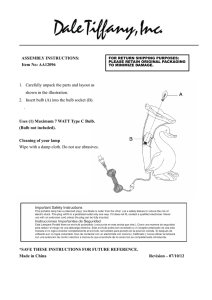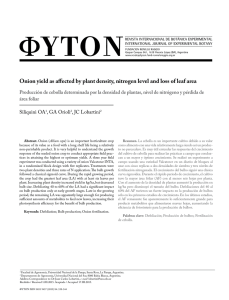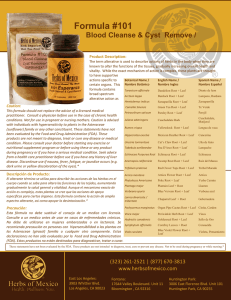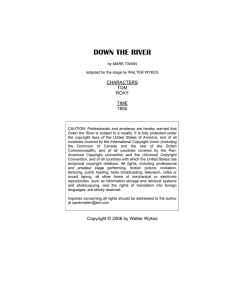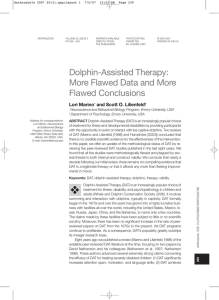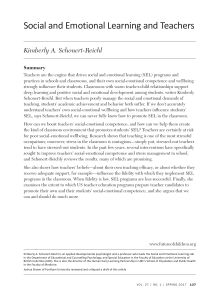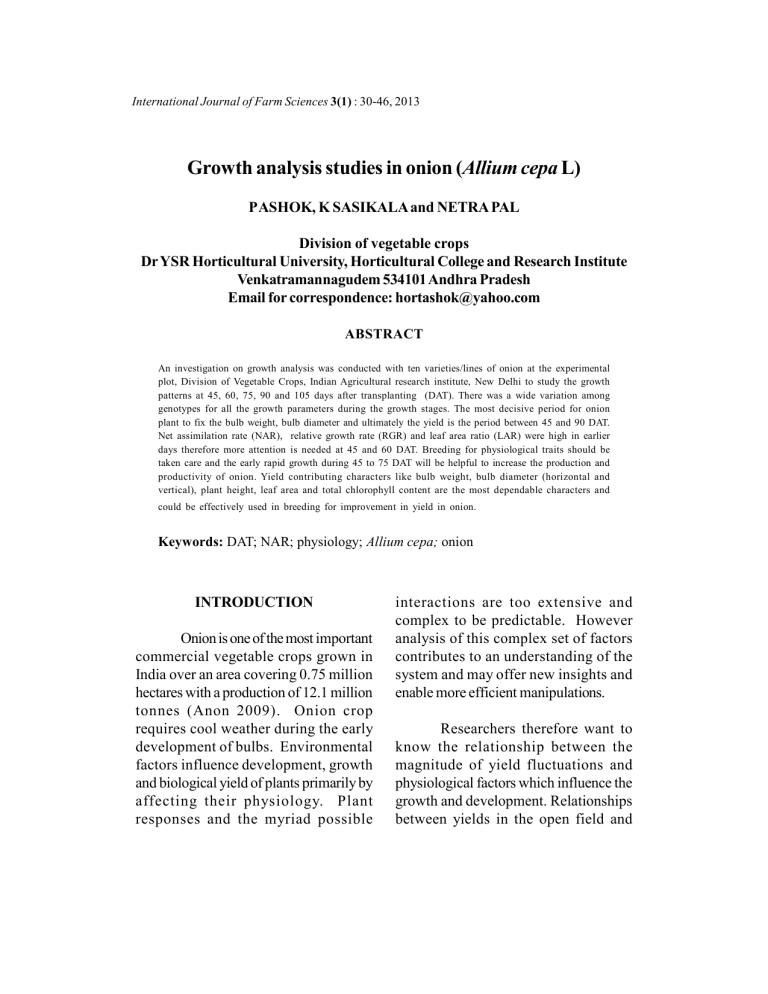
International Journal of Farm Sciences 3(1) : 30-46, 2013 Growth analysis studies in onion (Allium cepa L) P ASHOK, K SASIKALA and NETRA PAL Division of vegetable crops Dr YSR Horticultural University, Horticultural College and Research Institute Venkatramannagudem 534101 Andhra Pradesh Email for correspondence: hortashok@yahoo.com ABSTRACT An investigation on growth analysis was conducted with ten varieties/lines of onion at the experimental plot, Division of Vegetable Crops, Indian Agricultural research institute, New Delhi to study the growth patterns at 45, 60, 75, 90 and 105 days after transplanting (DAT). There was a wide variation among genotypes for all the growth parameters during the growth stages. The most decisive period for onion plant to fix the bulb weight, bulb diameter and ultimately the yield is the period between 45 and 90 DAT. Net assimilation rate (NAR), relative growth rate (RGR) and leaf area ratio (LAR) were high in earlier days therefore more attention is needed at 45 and 60 DAT. Breeding for physiological traits should be taken care and the early rapid growth during 45 to 75 DAT will be helpful to increase the production and productivity of onion. Yield contributing characters like bulb weight, bulb diameter (horizontal and vertical), plant height, leaf area and total chlorophyll content are the most dependable characters and could be effectively used in breeding for improvement in yield in onion. Keywords: DAT; NAR; physiology; Allium cepa; onion INTRODUCTION Onion is one of the most important commercial vegetable crops grown in India over an area covering 0.75 million hectares with a production of 12.1 million tonnes (Anon 2009). Onion crop requires cool weather during the early development of bulbs. Environmental factors influence development, growth and biological yield of plants primarily by affecting their physiology. Plant responses and the myriad possible interactions are too extensive and complex to be predictable. However analysis of this complex set of factors contributes to an understanding of the system and may offer new insights and enable more efficient manipulations. Researchers therefore want to know the relationship between the magnitude of yield fluctuations and physiological factors which influence the growth and development. Relationships between yields in the open field and Ashok et al intensities of distinct growth factors were tested in different crops. Sel 402, N-53, Sel 126, Early Grano, Pusa White Flat and Pusa White Round. In the bulb forming species like onion the situation is quiet complex because bulb development ultimately leads to cessation of foliage leaf production. Furthermore the longer the duration over which a leaf canopy is transferring photosynthates to harvestable material (bulb) the higher the yield. Therefore information on nature and magnitude of variation in growth and development pattern of onion genotypes is essential for successful crop improvement. The experiment was laid out in a Randomized Block Design (RBD) with three replications each consisting of 10 varieties/lines. Each variety/line was grown in 20 rows of 3 m long spaced at 15 cm apart. Fifteen plants were taken at random each in lines/varieties and tagged for recording observations. Observations were taken by uprooting the whole plant at 15 days intervals up to harvest. All the cultural operations like nursery raising, main field preparation, transplanting, fertilization, irrigation, weeding, plant protection etc were carried out as per the recommendations in order to raise a successful crop. Therefore the present investigations were carried out to study the variability in growth and development pattern of onion genotypes with respect to the prevailing tropical conditions to analyze the variations in growth and development patterns in onion cultivars/lines. Morphological observations which are used to study growth analysis were recorded for every 45, 60, 75, 90, 105 days after transplanting (DAT). The observations recorded were plant height, number of leaves per plant, neck thickness, weight of the bulb, bulb diameter (horizontal and vertical), fresh and dry weight of the bulbs and leaves, leaf area, chlorophyll content (Hiscox and Israelstam 1979), leaf area index (LAI) (Watson 1952), leaf area ratio (LAR) (Whitehead and Mycersough 1962), relative growth rate (RGR) (Blackman 1919), net assimilation rate (NAR) (Redford 1967) and crop growth rate (Watson 1952) . MATERIAL AND METHODS The experiment was carried out in the experimental plots of the Division of Vegetable Crops and laboratory works in the Division of Plant Physiology and Vegetable laboratory, Indian Agricultural Research Institute, New Delhi during 2002 - 2003. The experimental material for the present study consisted of ten lines/varieties viz Pusa Red, Pusa Madhvi, B-line, Sel 383, 31 Growth analysis in onion The analysis of variance for each character was according to procedures of Cochran and Cox (1950). RESULTS AND DISCUSSION Plant height All the varieties/lines showed their maximum plant height at 75 and 90 DAT (Table 1,2, 3, 4) but drastic increase in plant height at 60 DAT in all the varieties/ lines except in Sel 126 was noticed where rapid growth was observed at 75 DAT. These results revealed that Sel 126 was slow in vegetative growth even at 90 DAT showing its slow growth. Number of leaves Number of leaves gradually increased from 45 to 105 DAT except in Sel 383, Early Grano, Pusa Madhvi, Sel 402 and Pusa White Round where number of leaves decreased from 90 to 105 DAT (Table 1, 2, 3, 4, 5). In B-line, Sel 126, N53 and Pusa Red few leaves were produced from the centre of the plant. The growth of these newly developed leaves was completely restricted because of lack of light interception towards centre of the plant. Heath and Hollics (1965) gave similar reports regarding new leaf development from the centre of older leaf sheath. Bulb fresh weight and bulb dry weight Bulb fresh weight gradually increased from 45 to 105 DAT but rapid 32 increase in bulb fresh weight was observed at 75 DAT in all the varieties/lines (Table 1, 2, 3). Bulb dry weight also followed similar pattern. These results suggested that bulb initiation in onion takes place at 75 DAT. Leaf fresh weight and leaf dry weight Leaf fresh weight varied significantly and gradually increased from 45 to 90 DAT and thereafter it declined (Table 1, 2, 3, 4). Early Grano showed its superiority in leaf fresh weight up to 75 DAT but leaf fresh weight drastically decreased from 75-90 DAT. Leaf dry weight also followed similar pattern. Leaf fresh weight increased gradually upto 90 DAT but then gradually decreased indicating that translocation of photosynthates had taken place from leaves which attained maximum area (source) to bulb (sink) as fresh bulb weight increased gradually thereafter. According to Wiles (1994) a significant increase in bulb development lead to decrease in leaf area on the main shoot and the decrease in leaf area is the first indication of the initiation of storage scales. Horizontal and vertical bulb diameter Horizontal bulb diameter gradually increased from 45 to 105 DAT (Fig 7). But rapid increase was observed at 75 DAT. At 45 and 60 DAT Sel 126 Sel 383 and Pusa Madhvi showed their lowest values of horizontal bulb diameter. Vertical bulb diameter followed similar pattern. Early Grano showed the highest values of vertical bulb diameter at all stages of DAT Ashok et al (Table 1, 2, 3, 4). Horizontal bulb diameter increased at a faster rate at 90 and 105 DAT than vertical bulb diameter. These results suggested that demarcation in bulb shape took place at slag periods of bulb growth (Plate 4, 5). Neck thickness Neck thickness varied significantly and it increased up to 75 and 90 DAT and thereafter it declined gradually (Table 1, 2, 3, 4). Mann (1952) reported that as the bulb ripens the outermost one to three sheaths develop into thin dry protective skins. Since leaves cease to form from inner bulb scales the pseudostem becomes hollow. Therefore neck softens which results in decrease in neck thickness at 105 DAT. Physiological characters Leaf area Leaf area differed significantly and maximum leaf area was observed at 75 DAT (Fig 1). Early Grano maintained its maximum leaf area at 45, 60 and 75 DAT whereas it declined drastically at 90 and 105 DAT (Fig1). Shoba et al (1990) reported that leaf area decreased with plant age in cultivars selected due to leaf senescence (Plate 1 to 5). was observed at later stages (Table 1, 2, 3, 4). Chlorophyll-b was maximum at 45 and minimum at 105 DAT. Maximum total chlorophyll was observed at 45 and 60 DAT and minimum at 105 DAT. These results suggest that total chlorophyll content of the leaf was reduced which accelerated the senescence processes. Similar trend has been reported by Xhunga and Zafirati (1994). Leaf area index Maximum leaf area index recorded at 60 and 75 DAT and minimum at 105 DAT except in Sel 126 where highest LAI values recorded at 90 DAT and 105 DAT (Fig 2). Leaf area ratio (LAR) and net assimilation rate (NAR) Leaf area ratio varied significantly among the varieties/lines at all the stages of DAT. LAR declined from 45 to 105 DAT in Pusa Madhvi and B-line (Fig 3) whereas in other varieties LAR increased again at 75 DAT and thereafter it declined. In all the varieties/lines NAR was maximum at 45-60 DAT and minimum at 75-90 DAT. In Sel 126 maximum NAR was observed at 75-90 DAT (Fig 4). Relative growth rate (RGR) and crop growth rate (CGR) Maximum RGR values were recorded at 45-60 DAT except Sel 126 where maximum was recorded at 75-90 DAT (Fig 5). CGR was maximum at 7590 DAT except in Early Grano where Chlorophyll-a, Chlorophyll-b and total chlorophyll Chlorophyll-a showed significant differences and maximum chlorophyll-a content recorded at 75 and 90 DAT. Drastic decrease in chlorophyll-a content 33 34 25.4 33.0 27.0 30.5 33.1 25.1 20.8 32.2 30.4 28.3 4.7 PR EG PWF Sel 126 N-53 PM Sel 402 B-line PWR Mean CD 0.05 NS 4.9 5.0 4.7 5.5 4.7 4.3 5.0 5.3 6.0 4.3 0.72 2.69 4.49 1.66 2.37 2.17 3.86 1.78 3.16 3.27 1.82 2.30 wt (g) fresh Bulb 0.05 0.24 0.43 0.12 0.18 0.17 0.35 0.17 0.25 0.22 0.21 0.28 wt (g) dry Bulb 1.69 5.52 4.51 6.36 4.32 4.04 8.53 3.40 6.42 9.17 3.75 4.66 wt (g) fresh Leaf NS 0.50 0.45 0.52 0.37 0.33 0.62 0.39 0.60 0.90 0.27 0.57 wt (g) 0.02 1.13 1.21 1.11 1.11 0.89 1.10 1.00 1.31 1.31 1.21 1.04 (cm) bulb dia Leaf dry Horizontal 0.15 1.66 1.50 1.68 1.70 1.48 1.68 1.54 1.61 2.09 1.59 1.73 (cm) 0.08 0.97 1.03 0.91 1.20 1.08 0.98 0.74 1.07 1.07 0.77 0.83 (cm) Neck 0.04 0.24 0.21 0.29 0.31 0.29 0.21 0.12 0.18 0.31 0.27 0.19 FW) 0.12 1.19 0.88 1.49 1.54 1.23 0.86 0.79 1.33 1.42 1.51 0.81 FW) 0.09 1.72 1.38 2.08 2.06 1.80 1.38 1.17 1.86 2.01 2.10 1.37 content (mg g-1 FW) Chlorphyll Chlorphyll Total bulb dia thickness -a (mg g-1 -b(mg g-1 chlorophyll Verticla PR: Pusa Red, EG: Early Grano, PM: Pusa Madhvi, PWF: Pusa White Flat, PWR: Pusa White Round 25.2 4.7 of leaves height (cm) Number Plant Sel 383 Plant/line Table 1. Growth analysis of onion varieties/lines at 45 DAT Growth analysis in onion 35 45.5 43.2 52.3 44.3 3.5 Sel 402 B-line PWR Mean CD 0.05 1.4 6.3 7.3 5.0 5.6 5.7 7.4 5.0 6.0 7.0 6.0 0.68 5.24 8.45 3.45 6.26 2.63 7.56 2.38 5.28 8.72 4.33 0.22 1.87 3.23 1.81 1.72 0.54 3.87 0.48 1.98 2.84 1.69 0.57 wt (g) dry Bulb 1.58 19.39 20.75 19.55 26.75 14.25 22.29 9.58 19.38 27.79 13.57 19.95 wt (g) fresh Leaf 1.00 2.49 3.01 1.93 3.23 1.67 3.57 0.88 1.77 4.53 1.80 2.47 wt (g) 0.08 1.93 2.42 1.47 2.12 1.81 2.27 1.15 1.96 2.17 1.94 1.62 (cm) bulb dia Leaf dry Horizontal 0.19 2.42 2.66 1.93 2.48 2.06 2.47 1.83 2.61 3.22 2.34 2.61 (cm) 0.05 1.22 1.38 1.08 1.29 1.14 1.45 0.97 1.37 1.27 1.07 1.18 (cm) Neck NS 0.37 0.34 0.46 0.42 0.39 0.32 0.21 0.29 0.48 0.41 0.34 FW) 0.02 0.70 0.66 0.79 1.07 0.74 0.42 0.62 0.75 0.65 0.69 0.58 FW) 0.04 1.30 1.26 1.45 1.73 1.35 0.96 1.12 1.29 1.36 1.32 1.20 content (mg g-1 FW) Chlorphyll Chlorphyll Total bulb dia thickness -a (mg g-1 -b(mg g-1 chlorophyll Verticla PR: Pusa Red, EG: Early Grano, PM: Pusa Madhvi, PWF: Pusa White Flat, PWR: Pusa White Round 40.0 36.3 Sel 126 PM 42.1 PWF 51.7 52.0 EG N-53 27.3 PR 3.33 wt (g) 7.7 fresh height of leaves (cm) 52.8 Bulb Number Plant Sel 383 Plant/line Table 2. Growth analysis of onion varieties/lines at 60 DAT Ashok et al 36 54.2 50.1 55.1 53.4 4.1 Sel 402 B-line PWR Mean CD 0.05 NS 7.9 7.3 8.3 7.7 7.7 8.3 7.0 8.8 7.7 7.7 4.68 35.20 20.70 34.36 24.10 20.72 58.04 19.70 41.84 65.33 35.83 0.74 4.81 4.94 5.10 3.09 4.84 5.59 1.64 4.81 6.97 5.55 5.54 wt (g) dry Bulb 3.12 27.50 24.33 29.01 30.82 23.55 30.40 18.54 30.51 36.23 25.40 26.21 wt (g) fresh Leaf 1.28 4.13 4.15 4.76 4.07 3.74 5.56 2.53 3.61 5.50 3.81 3.53 wt (g) 0.16 4.25 3.63 4.11 3.91 3.77 4.61 3.84 4.74 5.27 4.41 4.23 (cm) bulb dia Leaf dry Horizontal 0.36 3.79 3.77 3.76 3.30 4.41 4.23 2.58 3.73 4.43 4.27 3.40 (cm) 0.10 1.71 1.77 2.02 1.64 1.76 1.72 1.51 1.64 1.56 1.75 1.72 (cm) Neck 0.04 0.54 0.42 0.64 0.62 0.71 0.38 0.43 0.48 0.67 0.53 0.51 FW) 0.04 0.48 0.36 0.56 0.74 0.52 0.24 0.49 0.62 0.52 0.37 0.42 FW) 0.06 1.23 1.00 1.36 1.56 1.46 0.92 1.09 1.39 1.40 1.07 1.09 content (mg g-1 FW) Chlorphyll Chlorphyll Total bulb dia thickness -a (mg g-1 -b(mg g-1 chlorophyll Verticla PR: Pusa Red, EG: Early Grano, PM: Pusa Madhvi, PWF: Pusa White Flat, PWR: Pusa White Round 55.9 50.2 Sel 126 PM 51.7 PWF 53.1 62.1 EG N-53 47.1 PR 31.34 wt (g) 8.3 fresh height of leaves (cm) 54.1 Bulb Number Plant Sel 383 Plant/line Table 3. Growth analysis of onion varieties/lines at 75 DAT Growth analysis in onion 37 54.0 42.0 50.1 50.3 54.8 50.2 47.0 50.1 50.3 4.5 EG PWF Sel 126 N-53 PM Sel 402 B-line PWR Mean CD 0.05 1.7 9.7 12.8 10.7 8.7 10.0 9.7 10.1 9.7 7.3 8.0 6.34 86.60 93.74 93.95 96.07 96.79 70.33 81.72 70.66 104.84 82.66 0.86 11.20 11.52 13.52 12.01 9.68 9.61 8.40 11.85 13.60 11.12 10.64 wt (g) dry Bulb 2.68 45.77 36.41 53.17 48.65 68.27 34.45 60.14 41.07 31.59 34.84 49.15 wt (g) fresh Leaf 1.44 6.62 4.97 5.87 7.44 9.44 7.38 9.48 8.49 3.56 3.97 5.55 wt (g) 0.07 5.78 5.84 6.27 5.39 5.84 5.67 6.06 5.81 5.87 5.42 5.66 (cm) bulb dia Leaf dry Horizontal 0.21 4.48 4.62 4.33 4.05 4.60 4.53 4.32 4.66 5.35 4.29 4.04 (cm) 0.07 1.61 1.61 1.72 1.43 1.92 1.68 1.62 1.81 1.38 1.25 1.66 (cm) Neck 0.04 0.54 0.58 0.51 0.54 0.62 0.45 0.62 0.51 0.49 0.51 0.55 FW) 0.02 0.24 0.18 0.32 0.39 0.28 0.14 0.17 0.26 0.26 0.15 0.21 FW) 0.03 1.00 0.99 0.99 1.22 1.09 0.81 1.10 1.00 0.91 0.93 1.01 content (mg g-1 FW) Chlorphyll Chlorphyll Total bulb dia thickness -a (mg g-1 -b(mg g-1 chlorophyll Verticla PR: Pusa Red, EG: Early Grano, PM: Pusa Madhvi, PWF: Pusa White Flat, PWR: Pusa White Round 53.3 PR 75.26 wt (g) 10.5 fresh height of leaves (cm) 51.6 Bulb Number Plant Sel 383 Plant/line Table 4. Growth analysis of onion varieties/lines at 90 DAT Ashok et al 38 45.7 43.0 48.0 45.5 4.7 Sel 402 B-line PWR Mean CD 0.05 1.5 9.6 11.3 11.0 8.3 8.0 11.2 11.3 10.0 6.0 9.0 5.30 106.59 98.74 123.09 116.08 96.62 84.33 82.01 104.96 162.02 97.21 1.05 12.75 12.24 14.21 14.53 10.01 11.01 8.75 15.63 15.98 13.57 11.56 wt (g) dry Bulb 2.40 23.40 25.26 29.53 23.34 24.25 28.17 18.19 22.29 18.93 19.63 24.39 wt (g) fresh Leaf NS 4.49 4.12 4.85 4.31 4.83 6.27 4.18 4.59 3.17 3.79 4.79 wt (g) 0.16 6.77 7.48 6.59 7.12 6.47 6.74 6.18 6.93 7.17 6.37 6.61 (cm) bulb dia Leaf dry Horizontal 0.24 4.95 5.73 4.72 4.42 4.62 4.77 4.74 4.86 6.40 4.47 4.77 (cm) 0.12 1.35 1.52 1.59 1.15 1.26 1.32 1.51 1.33 0.96 1.24 1.62 (cm) Neck 0.03 0.20 0.19 0.27 0.16 0.26 0.21 0.19 0.23 0.10 0.16 0.20 FW) 0.02 0.07 0.09 0.09 0.12 0.03 0.01 0.04 0.05 0.10 0.06 0.09 FW) 0.03 0.40 0.42 0.40 0.52 0.46 0.29 0.33 0.43 0.37 0.37 0.42 content (mg g-1 FW) Chlorphyll Chlorphyll Total bulb dia thickness -a (mg g-1 -b(mg g-1 chlorophyll Verticla PR: Pusa Red, EG: Early Grano, PM: Pusa Madhvi, PWF: Pusa White Flat, PWR: Pusa White Round 50.1 40.0 Sel 126 PM 41.2 PWF 48.2 41.8 EG N-53 51.0 PR 100.81 wt (g) 10.3 fresh height of leaves (cm) 45.6 Bulb Number Plant Sel 383 Plant/line Table 5. Growth analysis of onion varieties/lines at 105 DAT Growth analysis in onion Ashok et al Trends of Growth analysis of different varieties at different days after transplanting 39 Growth analysis in onion 40 Ashok et al 41 Growth analysis in onion 42 Ashok et al 43 Growth analysis in onion 44 Ashok et al maximum CGR values were recorded at 60-75 DAT (Fig 6). The large amount of variation existed in the germplasm revealed that considerable improvement can be made in this crop. Similar results were reported by Masika et al (1994). As the crop grows and LAI increases more and more leaves become shaded causing a decrease in NAR as the growing season progresses. Relative growth rate also showed similar pattern of NAR. This shows increase in the efficiency of available leaf and relatively high dry matter production at the earlier periods. Similar trend has been reported by Laju Paul (2000). CONCLUSION Based on the above mentioned findings of the present investigations it may be concluded that the period between 45 to 90 DAT is the most decisive period for onion plant to fix the bulb weight, bulb diameter and ultimately the yield. Breeding for physiological traits should be taken care and the early rapid growth during 45 to 75 DAT periods will be helpful to increase the production and productivity of onion. Bulb quality and yield characters recorded at maturity Maximum values for total soluble o solids ( Brix) were recorded for Sel 126 followed by Sel 402 whereas minimum for Early Grano followed by N-53. Reducing sugars ranged from 2.1 per cent (Sel 383) to 3.61 per cent (Early Grano). Sel 126 possessed highest non-reducing sugars followed by Pusa White Round. Total sugars ranged from 7.0 per cent (Sel 383) to 12.2 per cent (Sel 126). Pusa Red possessed the highest amount of ascorbic acid followed by Sel 126 (Table 6). Yield contributing characters like bulb weight, bulb diameter (horizontal and vertical), plant height, leaf area and total chlorophyll content are the most dependable characters and could be effectively used in breeding for improvement in yield. NAR, RGR and LAR are high at earlier days therefore more attention is needed at 45 and 60 DAT. Weight of the bulb ranged from 83.4 g (Sel 126) to 163.92 g (Early Grano). Bulb yield per plot was maximum in Early Grano followed by Sel 4.02 whereas minimum in Sel 126. Total yield ranged from 262.5 q/h (Sel 126) to 399.3 q/h (Early Grano). Marketable yield ranged from 210.62 q/h (Sel 383) to 343.75 q/h (Early Grano). REFERENCES Anonymous 2010. Indian Horticulture database 200910, NHB, Gurgaon, Haryana. Blackman VH 1919. The compound interest law in plant growth. Annals of Botany 33: 353-360. Cochran GW and Cox MG 1950. Experimental designs. John Wiley and Sons, New York. 45 Growth analysis in onion Heath OVS and Hollics MA 1965. Studies in the physiology of the onion plant VI. A sensitive morphological test for bulbing and its use in detecting bulb development in sterile culture. Journal of Experimental Botany 16: 128-144. Hiscox JD and Israelstom GF 1979. A method for extraction of chlorophyll from leaf tissue without maceration. Canadian Journal of Botany 57: 13321334. Redford PJ 1967. Growth analysis formulae their use and abuse. Crop Science 7: 171. Shoba H, Arunugam R and Halen S 1990. Physiology of growth and development of garlic (Allium sativum L). South Indian Horticulture 38(6): 323328. Watson DJ 1952. The physiological basis of variation in yield. Advances in Agronomy 4: 101-145. Laju Paul K 2000. Variability in morphological physiological and biochemical characters in Kalmegh (Andrographis paniculata Nees). MSc thesis, Kerala Agricultural University, Kerala. Whitehead FH and Mycer Sough PJ 1962. Growth analysis of plant ratio of mean relative growth rate to mean growth rate of increase of leaf area. New Physiologist 61: 314-321. Mann LK 1952. Anatomy of the garlic bulb and factors affecting bulb development. Hilgardia 1(8): 195251. Wiles GC 1994. The effect of different photoperiods and temperatures following bulb initiation on bulb development in tropical onion cultivars. Acta Horticulture 358: 419-427. Masika RL, Jackson JE, Currah L and Midmore DJ 1994. Selection of onion cultivars for yield, carlinen in cropping and storage potential in Zimbabwe. Acta Horticulturae 358: 235-238. Xhunga S and Zafirati V 1994. Relationship between assimilate supply and the economic productivity of late tomatoes. Bujqesia shquiptare 4: 24-25. Received : 6.3.2012 Accepted : 31.7.2012 46
